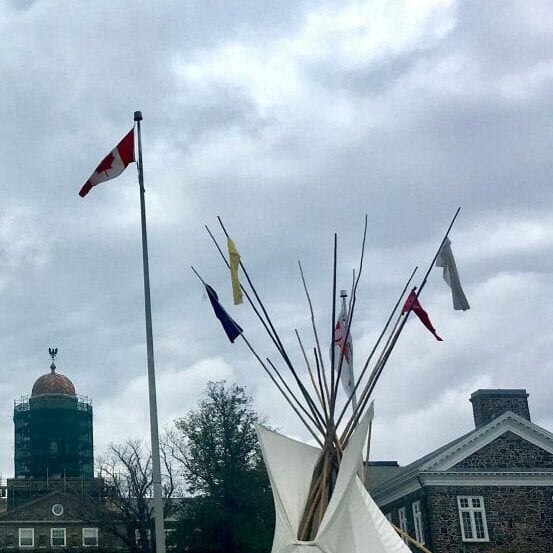
Schulich School of Law teaching new course Aboriginal and Indigenous Law in Context
New course based on recommendation from 2015 Truth and Reconciliation Commission report
On January 9, 2018, Reagan Seidler, a first-year student at Dalhousie’s Schulich School of Law, took to Twitter to announce the school’s recent suggestion for first-year law students to include land acknowledgments in their email signatures.
Lindsay Loomer, Schulich’s Director of Communications and Marketing, did not classify it as a suggestion from the law school. Rather, it was one of a number of suggestions on a card that a professor handed out to the students in the school’s Aboriginal and Indigenous Law in Context class. The school decided to create that class in response to a report issued by the Truth and Reconciliation Commission of Canada in 2015.
“People were really engaged with what they were learning,” Loomer said over the phone about the application of the report’s recommendations in law school. “They were saying, ‘what else can I do to make steps towards reconciliation a part of my daily life?’”
Seidler said he appreciated the way the his professor provided the suggestions, which the professor did in response to the class asking for other ways they could bring reconciliation into their daily lives, according to Loomer.
“The law school did well. They gave students an option and let them explore it further,” Seidler wrote in an email on the subject. “Dal just needs to be careful, given its recent missteps, that it maintains space for healthy debate. I hope they’ve learned from the Masuma Khan affair that imposing political values onto a campus causes problems.”
Seidler’s tweet was a reply to a post by a Wilfrid Laurier University student who tweeted that she wondered “how Indigenous people feel about holier-than-thou ‘SJWs’ who use land acknowledgments to virtue signal.”
The student included a picture of a Wilfrid Laurier course syllabus with a land acknowledgment stating: “We acknowledge that we live, learn and work on the traditional territories of the Neutral, Anishinaabe and Haudenosaunee peoples.”
“At the right time, acknowledgments are a respectful sign,” Seidler wrote. “But they run the risk of being used, or overused, to drive a political agenda. We can’t ignore the many others – veterans, public servants, volunteers – who also helped build this country.”
Responses to Seidler’s tweet ranged from remarks of debate to criticism and outright mockery of the suggestion.
Ali Barnaby is Vice-President of the Dalhousie Indigenous Students Collective and not surprised by the negative comments.
“The responses on Twitter for me just reinforce my belief that there’s still a lot of work to be done in terms of educating the broader public on treaties and the special relationships Indigenous Nations hold with the Crown and Canadian government,” Barnaby wrote in an email response to the Twitter feedback.
While Barnaby believes that the suggestion is a “positive step in the right direction,” she emphasised the need for consideration of the language used in land acknowledgment signatures.
Barnaby wrote that her “hope is that students who do choose to participate in this gesture of reconciliation understand the importance of the language they use.”
Barnaby further explained that the nature of the language used in land acknowledgment signatures is essential to the historical accuracy of the narrative being told.
“[W]hen speaking about Mi’kma’gi, the use of ‘traditional’ over ‘unceeded and unsurrendered’ territory, in my opinion, reinforces the false colonial narrative that L’nu people are a conquered nation – which couldn’t be further from the truth,” Barnaby explained in the email. “If anything, I think the Peace and Friendship Treaties are a testament to the strength of Mi’kmaw diplomacy and that strength deserves recognition.”
Accurate use of language in land acknowledgment signatures is crucial, as thoughtful language builds understanding. In order to understand the complexity of an action, sometimes you have to go beyond the 280 character count.
Correction: A previous version of this article stated that the law school directly suggested students use land acknowledgements in their email signature. Rather, the professor of the Aboriginal and Indigenous Law in Context class handed out cards with a number of reconciliation suggestions at the students’ request, and one of those suggestions was to include land acknowledgements in their email signatures. The Gazette apologizes for the error.






